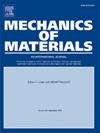Effective strain in simple shear deformation considering material anisotropy
IF 3.4
3区 材料科学
Q2 MATERIALS SCIENCE, MULTIDISCIPLINARY
引用次数: 0
Abstract
The effective strain in simple shear was explored with material anisotropy by providing its mathematical expression. Based on large deformation theory, the kinematics of simple shear was analyzed with discretization of the deformation process and decomposition of the deformation gradient, from which expressions that can be practically utilized for evaluating effective strain were derived for simple shear. Material anisotropy was considered by using the quadratic anisotropic yield function with Lankford values. It was found that the effective strain in simple shear can be accurately estimated as the number of the discretized deformation steps approaches infinity. It was verified that the derived expression can also be obtained from other approaches based on the co-rotational rate of deformation tensor and the plastic work equivalence, respectively. To demonstrate its application, the effective strains of several anisotropic metals made of steel alloys and aluminum alloys were evaluated using the developed expression. It was found that the effective strain of the extruded aluminum profile differs significantly from those of the other metals due to its strong planar anisotropy. This result demonstrates that the effective strain in simple shear can be significantly influenced by material anisotropy. Further investigations were conducted on the evaluation of effective strain in cases where simple shear is approximated by a finite number of increments, deriving relevant expressions for effective strain. Effective strains calculated from these expressions showed good correlations with those obtained from the incremental computations using the commercial finite element software Abaqus/Standard.
考虑材料各向异性的简单剪切变形有效应变
从材料各向异性的角度探讨了单剪有效应变的数学表达式。基于大变形理论,对单剪切进行运动学分析,对变形过程进行离散化,对变形梯度进行分解,推导出可实际用于单剪切有效应变计算的表达式。采用具有Lankford值的二次各向异性屈服函数来考虑材料的各向异性。结果表明,当离散化变形阶数趋近于无穷大时,单剪有效应变可以精确估计。验证了分别基于变形张量的共旋转速率和塑性功等效的其他方法也可以得到导出的表达式。为验证该表达式的应用,对几种各向异性金属的有效应变进行了计算。结果表明,挤压铝型材由于具有较强的平面各向异性,其有效应变与其他金属有明显的不同。结果表明,材料各向异性对单剪有效应变有显著影响。进一步研究了用有限次增量近似简剪时有效应变的计算,推导出有效应变的相关表达式。由这些表达式计算出的有效应变与利用商业有限元软件Abaqus/Standard进行增量计算得到的有效应变具有良好的相关性。
本文章由计算机程序翻译,如有差异,请以英文原文为准。
求助全文
约1分钟内获得全文
求助全文
来源期刊

Mechanics of Materials
工程技术-材料科学:综合
CiteScore
7.60
自引率
5.10%
发文量
243
审稿时长
46 days
期刊介绍:
Mechanics of Materials is a forum for original scientific research on the flow, fracture, and general constitutive behavior of geophysical, geotechnical and technological materials, with balanced coverage of advanced technological and natural materials, with balanced coverage of theoretical, experimental, and field investigations. Of special concern are macroscopic predictions based on microscopic models, identification of microscopic structures from limited overall macroscopic data, experimental and field results that lead to fundamental understanding of the behavior of materials, and coordinated experimental and analytical investigations that culminate in theories with predictive quality.
 求助内容:
求助内容: 应助结果提醒方式:
应助结果提醒方式:


